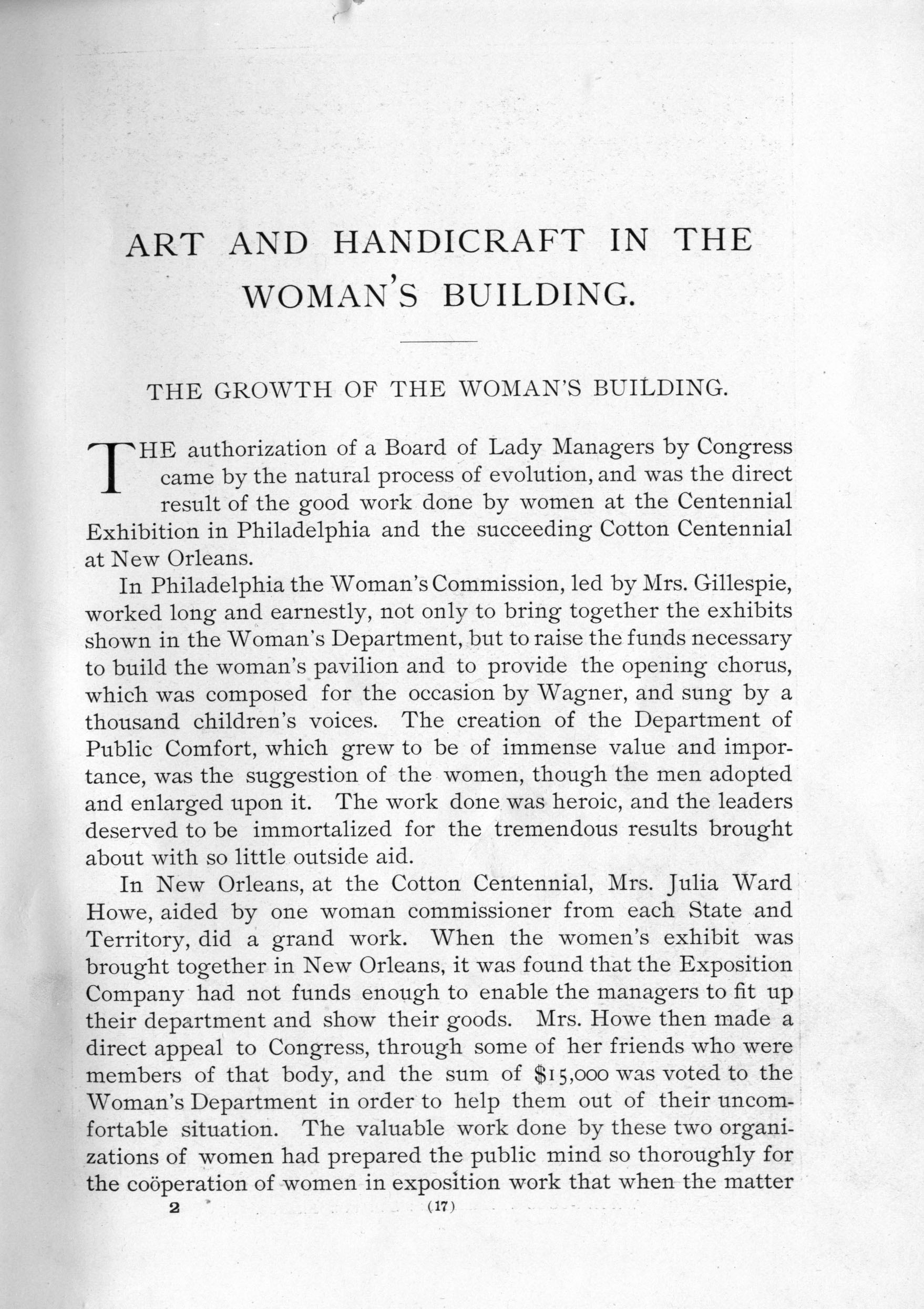
ART AND HANDICRAFT IN THE
WOMAN'S BUILDING.
THE GROWTH OF THE WOMAN'S BUILDING.
THE authorization of a Board of Lady Managers by Congress came by the natural process of evolution, and was the direct result of the good work done by women at the Centennial Exhibition in Philadelphia and the succeeding Cotton Centennial at New Orleans.
In Philadelphia the Woman's Commission, led by Mrs. Gillespie, worked long and earnestly, not only to bring together the exhibits shown in the Woman's Department, but to raise the funds necessary to build the woman's pavilion and to provide the opening chorus, which was composed for the occasion by Wagner, and sung by a thousand children's voices. The creation of the Department of Public Comfort, which grew to be of immense value and importance, was the suggestion of the women, though the men adopted and enlarged upon it. The work done was heroic, and the leaders deserved to be immortalized for the tremendous results brought about with so little outside aid.
In New Orleans, at the Cotton Centennial, Mrs. Julia Ward Howe, aided by one woman commissioner from each State and Territory, did a grand work. When the women's exhibit was brought together in New Orleans, it was found that the Exposition Company had not funds enough to enable the managers to fit up their department and show their goods. Mrs. Howe then made a direct appeal to Congress, through some of her friends who were members of that body, and the sum of $15,000 was voted to the Woman's Department in order to help them out of their uncomfortable situation. The valuable work done by these two organizations of women had prepared the public mind so thoroughly for the coöperation of women in exposition work that when the matter
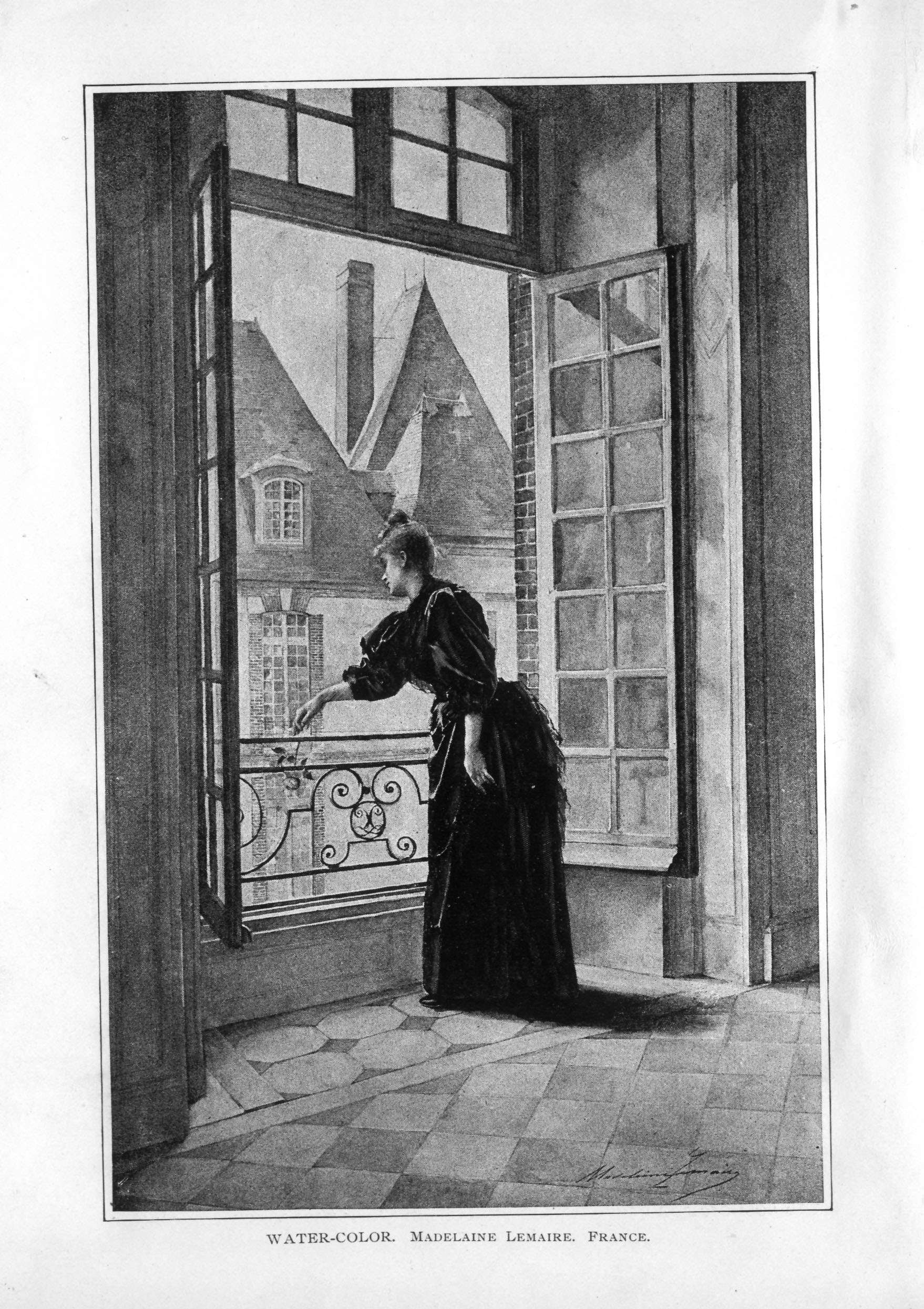
WATER-COLOR.
MADELAINE LEMAIRE.
FRANCE.

was brought before the World's Fair Committee of Congress, Mr. Springer of Illinois willingly inserted the clause authorizing the creation of the board of women, and championed it in the committee and before the House, where it met with no serious opposition.
The Board of Lady Managers was created by an Act of Congress, Section 6 of which reads as follows: "And said Commission is authorized and required to appoint a Board of Lady Managers of such number and to perform such duties as may be prescribed by said Commission. Said board may appoint one or more members of all committees authorized to award prizes for exhibits which may be produced in whole or in part by female labor."
Upon the assembling of the Board of Lady Managers in Chicago, we found that the first important duty to be settled was whether the work of women at the Fair should be shown separately or in conjunction with the work of men under the general classifications. This was a burning question, for upon this subject every one had strong opinions, and there was great feeling on both sides, those who favored a separate exhibit believing that the extent and variety of the valuable work done by women would not be appreciated or comprehended unless shown in a building separate from the work of men. On the other hand, the most advanced and radical thinkers felt that the exhibit should not be one of sex, but of merit and that women had reached the point where they could afford to compete side by side with men, with a fair chance of success, and that they would not value prizes given upon the sentimental basis of sex.
Both in Philadelphia and New Orleans the plan of separate exhibits had been carried out as well as possible; but in both cases the friends of women were disappointed by the meager showing made when the work done by women alone was separated, and they were not credited with the immense amount, both in variety and volume, which women had done in conjunction with men.
From the farm the dairy products went into the general exhibit, presumably as men's work. The interesting and unusually attractive showing of the bee and silk-worm industries, although prepared largely by women, went also into the general classification; and so with the thousand and one articles made in the factories of the world by men and women working conjointly; for women's distinctive part could not be separated without destroying the finished article.
In our body the vote on this question did not come up directly,

MINIATURE—"TOILET OF VENUS." MME. HERVÉ. FRANCE.

but indirectly, when it was decided, and I think wisely, that there should be no separate exhibit, but that each manufacturer should be expected to state whether his exhibit was in whole or part the work of women; and that we should have some device indicating this fact placed thereon, so that all who go through the Exposition and are at all interested in this matter can easily see a statement of the facts.
Our request to the Committee of Installation to put the necessary questions in the entry blanks, then being prepared to send to proposed exhibitors, was immediately granted, and almost all of the manufacturers who sent in their applications for space answered our questions, the first being: "Was this article produced wholly or in part by the work of women?" The affirmative answer to this question entitles us to members on the juries of award—a most important privilege for the protection of women's interests, which was conferred upon us by Congress. A good illustration was given of the lack of appreciation of the universality of woman's work in the world, when I asked one of the members of the Board of Control, at the time they were prescribing our duties, how many representatives we might have on the juries which would pass upon exhibits that were wholly or in part the work of women. His reply was that we might appoint all the members of those juries; that they were perfectly willing for us to name the entire jury that was to award prizes in departments where women's work was to be judged. This was so overwhelming, that I modestly insisted that we name only one-half of such juries, as otherwise, though I did not tell him so, we should have had the appointing of all the members of all the juries of the Exposition, except in very few of the departments of classification.
The desire of the Board of Lady Managers is to present a complete picture of the condition of women in every country of the world at this moment, and more particularly of those women who are bread-winners. We wish to know whether they continue to do the hard, wearing work of the world at prices which will not maintain life, and under unhealthy conditions; whether they have access to the common schools and to the colleges, and after having taken the prescribed course are permitted graduating honors; whether the women, in countries where educational facilities are afforded them, take a higher stand in all the active industries of life as well as in intellectual pursuits; how large the proportion is of those who have shown themselves capable of taking honors in the colleges to which they are admitted, etc.
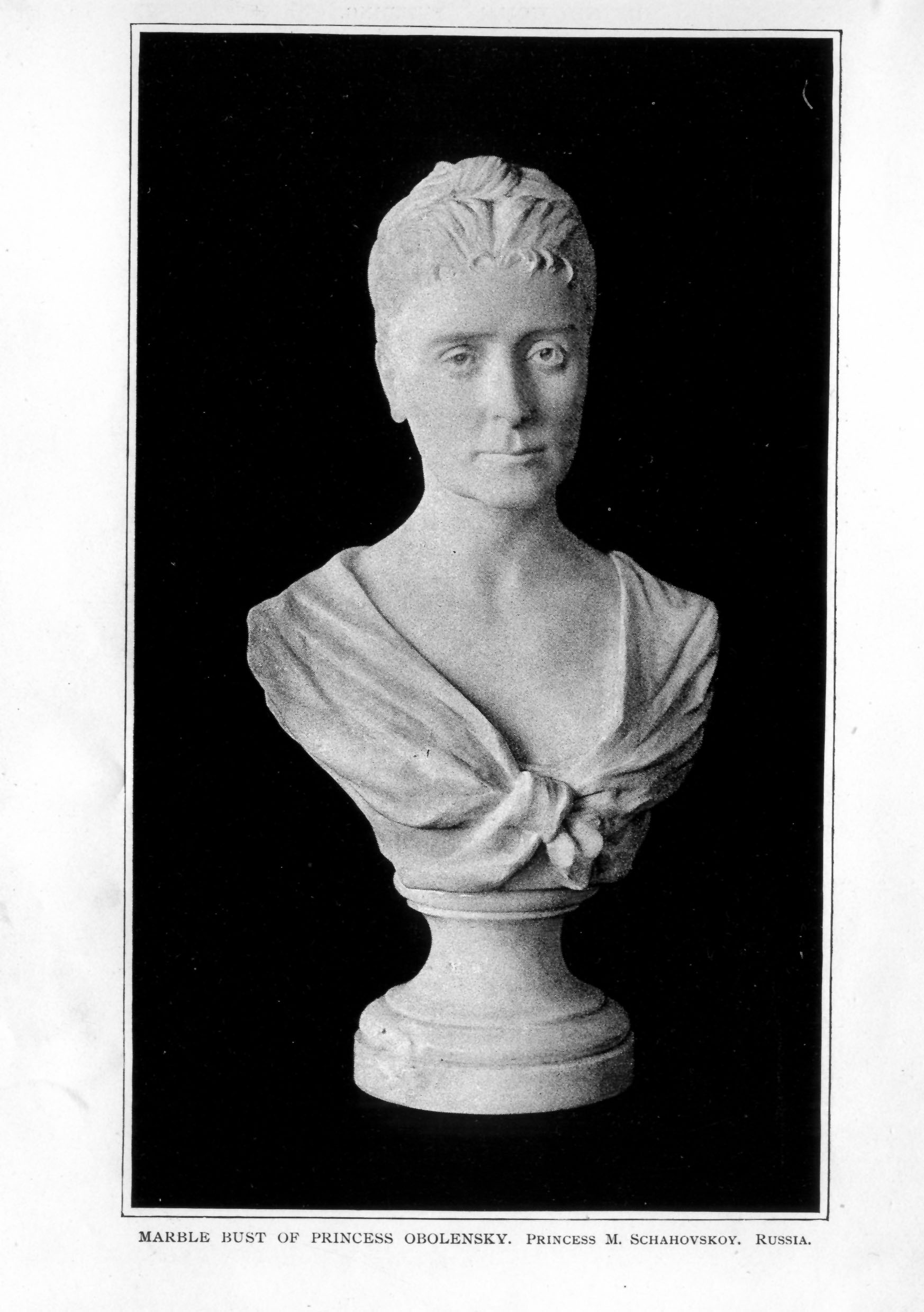
MARBLE BUST OF PRINCESS OBOLENSKY. PRINCESS M. SCHAHOVSKOY. RUSSIA.
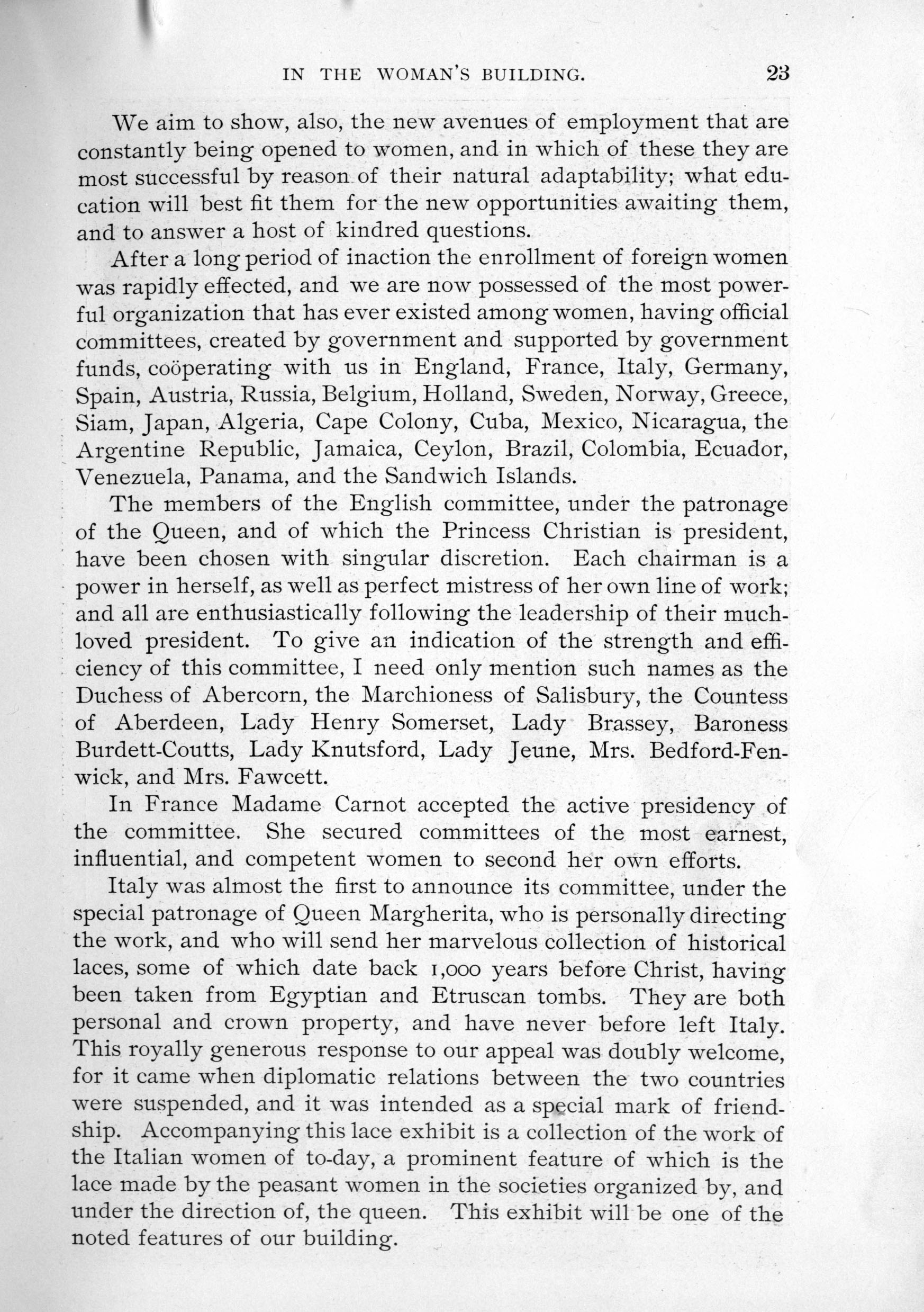
We aim to show, also, the new avenues of employment that are constantly being opened to women, and in which of these they are most successful by reason of their natural adaptability; what education will best fit them for the new opportunities awaiting them, and to answer a host of kindred questions.
After a long period of inaction the enrollment of foreign women was rapidly effected, and we are now possessed of the most powerful organization that has ever existed among women, having official committees, created by government and supported by government funds, coöperating with us in England, France, Italy, Germany, Spain, Austria, Russia, Belgium, Holland, Sweden, Norway, Greece, Siam, Japan, Algeria, Cape Colony, Cuba, Mexico, Nicaragua, the Argentine Republic, Jamaica, Ceylon, Brazil, Colombia, Ecuador, Venezuela, Panama, and the Sandwich Islands.
The members of the English committee, under the patronage of the Queen, and of which the Princess Christian is president, have been chosen with singular discretion. Each chairman is a power in herself, as well as perfect mistress of her own line of work; and all are enthusiastically following the leadership of their much-loved president. To give an indication of the strength and efficiency of this committee, I need only mention such names as the Duchess of Abercorn, the Marchioness of Salisbury, the Countess of Aberdeen, Lady Henry Somerset, Lady Brassey, Baroness Burdett-Coutts, Lady Knutsford, Lady Jeune, Mrs. Bedford-Fenwick, and Mrs. Fawcett.
In France Madame Carnot accepted the active presidency of the committee. She secured committees of the most earnest, influential, and competent women to second her own efforts.
Italy was almost the first to announce its committee, under the special patronage of Queen Margherita, who is personally directing the work, and who will send her marvelous collection of historical laces, some of which date back 1,000 years before Christ, having been taken from Egyptian and Etruscan tombs. They are both personal and crown property, and have never before left Italy. This royally generous response to our appeal was doubly welcome, for it came when diplomatic relations between the two countries were suspended, and it was intended as a special mark of friendship. Accompanying this lace exhibit is a collection of the work of the Italian women of to-day, a prominent feature of which is the lace made by the peasant women in the societies organized by, and under the direction of, the queen. This exhibit will be one of the noted features of our building.

OIL PAINTING—LANDSCAPE. FRAULEIN VON KENDELL. GERMANY.

Russia, which has a committee organized by the Empress herself, sends its remarkable laces and embroideries, and many curious national costumes, which are very picturesque and attractive, both in color and design.
Japan at first hesitated, and refused to appoint a committee, but M. de Guerville had the good fortune to be permitted to give his lecture before the Emperor and Empress of Japan, and so interested the latter that she consented to become the head of a committee of ladies with whom we are now in active correspondence.
From parts of South America we shall rely mainly upon the kindly coöperation of the Latin-American department, which will send us such native work as can be spared from its own rich and varied collection. Although we have coöperating committees there, they have as yet made no definite reports as to what we may expect from them.
Madame Diaz has most kindly coöperated with us, and has offered for our building, in addition to other novel attractions, an orchestra of Mexican girls in rich costumes, who will play the national Mexican airs.
It will be seen that the names on our foreign committees represent not only royalty and the influence of government but include also many women who have risen to the positions which they occupy by their own unaided talents, who, without titles or wealth to assist them, are recommended only by their evident ability to carry on the important lines of work intrusted to their hands.
The powerful organization which we have secured extends around the world, and stands with perfect solidarity for the purpose of serving the interests of our sex and making the industrial conditions easier for them. We have such an organization as has never before existed of women for women. That this work is needed is evidenced by the pathetic answers from some of the countries where our invitation has been declined. For instance, a letter received from the government of Tunis states that a commission of women can not be formed in that country, because local prejudice will not allow the native women to take part in public affairs. Syrian correspondents write that it will be impossible to secure the official appointment of a committee of women in that country, as custom prevents women from taking hold of such work, and the government will lend no aid; but that an effort will be made to send a small exhibit, unofficially. Other oriental countries make the same reports—no schools; women not intelligent enough to undertake the work; public prejudice, etc. It seems incredible

ADMINISTRATION BUILDING.
SIZE, MAIN BODY, 100 X 100 FEET; PAVILIONS, 84 X 84 FEET; HEIGHT OF DOME, 275 FEET. ARCHITECT, MR. RICHARD M. HUNT. COST, $450,000.

that the governments of these countries would be willing to make admissions which reflect so much upon themselves, or that they would allow these shameful conditions to continue. The oppressive bonds laid upon women, both by religion and custom, are in some cases so strong as to be insurmountable, probably, during the present generation. A lady eminent for her work on behalf of the women of India, has informed me that the difficulty in doing anything for them is their absolute mental inactivity and their lack of desire to change their condition; they are so bound by the prevailing laws of caste and the prejudices that exist, that they have no wish for different surroundings; the desire for something better must be created before anything can be done to help them.
We have the hopeful fact to record, however, that even where the night has seemed the darkest, we have received letters from native women, to whom the dawn of a brighter day is visible, showing a full comprehension of the situation and an awakened intelligence. These women are working in their feeble way to send us, unofficially, such an exhibit as they can get together, notwithstanding official refusals. It is unfortunate that we can not hope to have women from the Orient present in large numbers at the Exposition, so that they might profit by its civilizing influences.
When our building was planned, we thought with some anxiety of the difficulty we would experience in getting creditable objects to fill so vast a space, but now we find that a building four or five times as large would have been inadequate. I now feel sure that notwithstanding the disappointments to exhibitors, this is a benefit to the quality of the collection, for such a vigorous process of elimination has been required in order to bring the exhibits within the bounds assigned, that it has resulted in the exclusion of all but the most desirable and attractive objects.
The moment of fruition has arrived. Hopes which for more than two years have gradually been gaining strength and definiteness have now become realities. The Exposition has opened its gates. On the occasion of the formal opening of the Woman's Building the Board of Lady Managers was singularly fortunate in having the honor of welcoming distinguished official representatives of many of the able foreign committees, and of the State boards which have so effectively coöperated with it in accomplishing results now disclosed to the world. We have traveled together a hitherto untrodden path, have been subjected to tedious delays, and overshadowed by dark clouds which threatened disaster to our enterprise. We have been obliged to march with peace offerings

OIL PAINTING—"A VISION."
FRAU BIEBER BOHM.
GERMANY.

in our hands, lest hostile motives be ascribed to us. Our burdens have been greatly lightened, however, by the spontaneous sympathy and aid which have reached us from women in every part of the world, and which have proved an added incentive and inspiration.
When our invitation asking coöperation was sent to foreign lands, the commissioners already appointed generally smiled doubtfully, and explained that their women were doing nothing; that they would not feel inclined to help us, and in many cases stated that it was not the custom of their country for women to take part in any public effort; that they only attended to their social duties, drove in the parks, etc. But as soon as these ladies received our message, sent in a brief and formal letter, the free-masonry among women proved to be such that it needed no explanation; they understood at once the possibilities. Strong committees were immediately formed of women having large hearts and brains—women who can not selfishly enjoy the ease of their own lives without giving a thought to their helpless and wretched sisters.
Our unbounded thanks are due to the exalted and influential personages who became, in their respective countries, patronesses and leaders of the movement inaugurated by us to represent what women are doing. They entered with appreciation into our work for the Exposition, because they saw an opportunity—which they gracefully and delicately veiled behind the magnificent laces forming the central objects in their superb collections—to aid their women by opening new markets for their wares.
This was the earnest purpose of their majesties the Empress of Russia and Queen of Italy, both so noted for the progressive spirit they have displayed in promoting the welfare of the women under their kindly rule. They have sent large collections of the work of peasant women, through organizations which exist under their patronage for selling their handiwork.
The committee of Belgian ladies was kind enough to take special pains to comply with our request for statistics concerning the industries and condition of women, notwithstanding the fact that the collecting of statistics is not in Europe so popular as with us. It has sent complete reports, attractively prepared in the form of monographs and charts, giving details which have been secured only by great personal effort. Such figures have never before been obtained in that country, and the committee itself is surprised at the great amount of novel and valuable information it has succeeded in presenting.

Her Majesty the Queen of England has kindly sent an exhibit of the work of her own hands, with the message that while she usually feels no interest in expositions, she gives this special token of sympathy with the work of the Board of Lady Managers because of its efforts for women. That the English committee has included in its exhibit and in its catalogue a plea for the higher education of women is in itself a significant fact.
Her Majesty the Queen of Siam has sent a special delegate with directions that she put herself under our leadership and learn what industrial and educational advantages are open to women in other countries, so that Siam may adopt such measures as will elevate the condition of her women.
The Exposition will thus benefit women, not alone by means of the material objects brought together, but there will be a more lasting and permanent result through the interchange of thought and sympathy among influential and leading women of all countries, now for the first time working together with a common purpose and an established means of communication. Government recognition and sanction give to these committees of women official character and dignity. Their work has been magnificently successful, and the reports which will be made of the conditions found to exist will be placed on record as public documents among the archives of every country.
We rejoice in the possession of this beautiful building, in its delicacy, symmetry, and strength. We honor our architect and the artists, who have given not only their hands but their hearts and their genius to its decoration.
The eloquent president of the Commission last October dedicated the great Exposition to humanity. We dedicate the Woman's Building to an elevated womanhood, knowing that by so doing we shall best serve the cause of humanity.
To serve as a permanent record of the many rare and beautiful objects now gathered in the Woman's Building, which will so soon be scattered to the four corners of the earth, this illustrated volume has been prepared. We greatly regret that lack of time and space has prevented our doing complete justice to the achievements of our sex, but hope that what has been accomplished may prove of service as a basis for future work.
BERTHA HONORÉ PALMER.

MARBLE STATUE—"SPRING."
MME. L. CONTAN.
FRANCE.
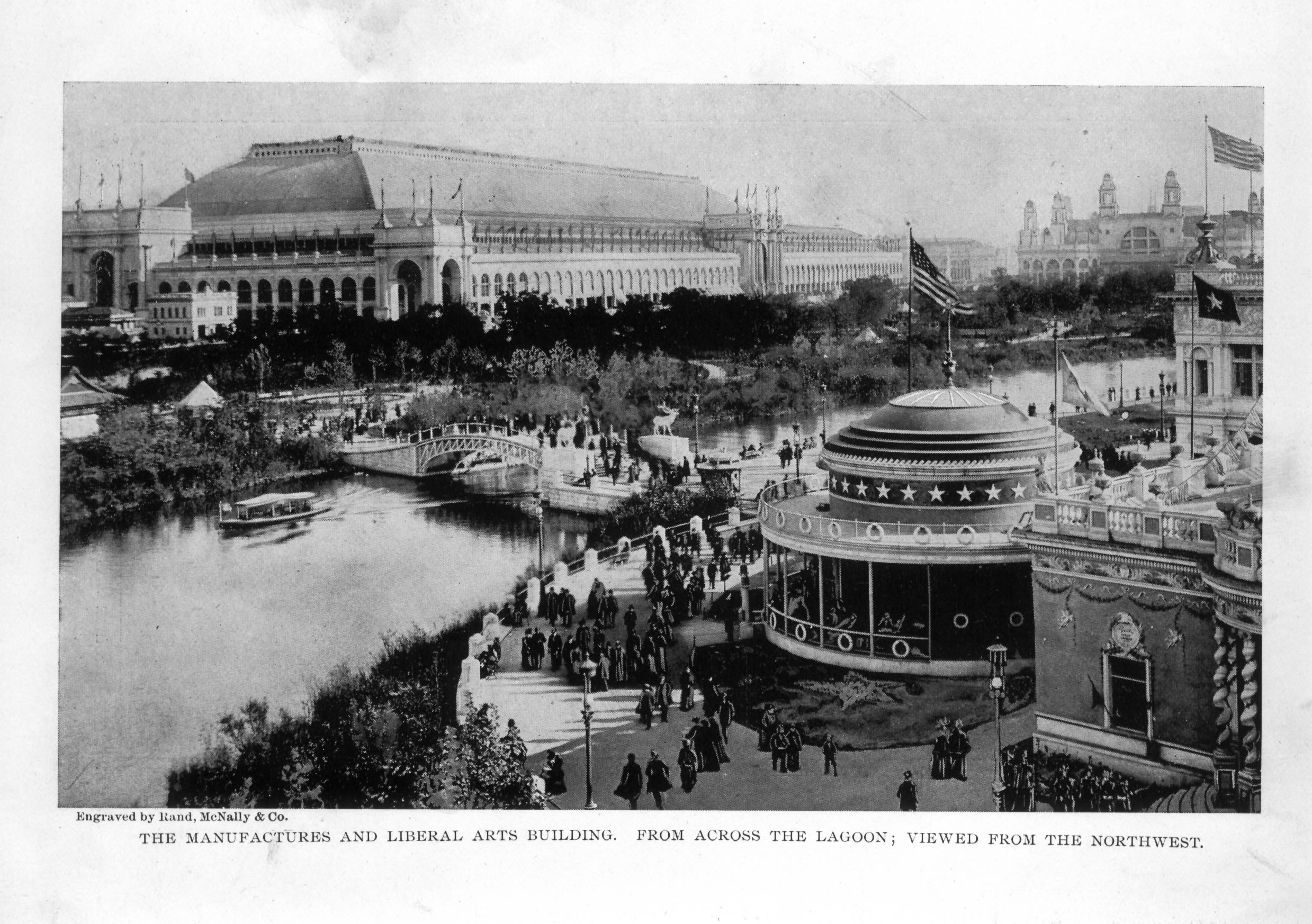
Engraved by Rand McNally & Co.
THE MANUFACTURES AND LIBERAL ARTS BUILDING.
FROM ACROSS THE LAGOON; VIEWED FROM THE NORTHWEST.